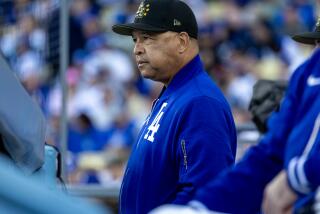Stroke of Fate
- Share via
The 18-year-old third baseman had no power and no speed. His defense was below average, his throwing was arm weak. When his first season of professional baseball ended in 1976, Wade Bogs returned to his home in Florida while his future was discussed in Boston. The early returns were not promising.
“Everything was below average,” said Dick Berardino, the Elmira Red Sox manager in 1976. “He had the work ethic and the dedication to the game, but I projected him to be only a triple-A player at best. That’s all.”
As Boggs strides today into the Hall of Fame at Cooperstown, N.Y., his journey should provide hope for any player languishing in the minor leagues. While the Red Sox were one of the best organizations in baseball in the late 1970s, Boggs was dismissed and overlooked.
When he finally reached the major leagues in 1982, Boggs was two months shy of his 24th birthday and coming off six seasons in the minors. Only after hitting .349 as a rookie did Boggs earn the third base job with Boston.
When he retired after the 1999 season, Boggs was statistically among the finest third basemen ever. He had 3,010 hits, a .328 average, a .415 on-base percentage, and his career was punctuated by a run of seven consecutive seasons with 200 hits or more.
Yet, Boggs barely earned an opportunity with the Red Sox. There were two seasons with double-A Bristol and two with triple-A Pawtucket. He hit .318 with a .415 on-base percentage in the minors, but the Red Sox focused on his lack of power -- nine home runs and a .386 slugging percentage.
And his career began inauspiciously, as Boggs hit .263 with no home runs and a .296 slugging percentage for Class-A Elmira.
“Like a lot of kids, he struggled,” Berardino said. “But even after he left [Elmira], no one was sure about him. He was playing a power position and he didn’t hit for power. It wasn’t just [the Red Sox], either. Anyone could have had him. He was left unprotected and any team could have had him. No one took him.”
Boggs seemed to use the lack of respect as incentive, becoming one of the premier hitters in the 1980s. He talked throughout his career about his slow rise, but there is no lingering bitterness.
“I call it seasoning,” Boggs said. “Once I got to the big leagues at 23, I was ready and I was ready to play every day.”
To this day, though, Boggs needles Berardino. It was Berardino who talked to Red Sox management about sending Boggs home a few months into his career and it was Berardino who labeled Boggs a non-prospect after that first season.
“I get on him all the time ... ‘Wow, you’re a great evaluator of talent, Dick,’ ” Boggs said.
The Red Sox drafted Boggs in the seventh round in 1976, but it took pleading from scout George Digby before the organization was convinced. Boggs was a shortstop in high school in Tampa, Fla., and labeled a marginal prospect.
Digby convinced the Red Sox that Boggs’ ability to hit and reach base outweighed his lack of power, speed, and defense. “I always say that George Digby is a visionary,” Boggs said. “He can see a lot of things that a lot of other people can’t....I was very fortunate to have him be that visionary because it gave me the opportunity in ’76 to be drafted.”
But even after Boggs established himself with the Red Sox, he was never embraced by the baseball establishment. Besides hitting 24 home runs in 1987, he lacked power and he was often considered only an average defensive third baseman.
Boggs worked on his defense, fielding grounders from former Red Sox shortstop Johnny Pesky every day. In 1994 and 1995, he won Gold Gloves. Offensively, he was rarely appreciated. Boggs scored 100 runs or more in seven consecutive seasons and he reached base more consistently than any player in his era.
In 1988, he hit .366 with a .476 on-base percentage. He led the American League in on-base percentage six times, he won five batting titles and twice led the league in runs.
Those numbers are valued in the age of “Moneyball,” but Boggs was seen as a selfish player in the 1980s. Critics said he was more concerned with padding his batting average than producing runs.
“They’re looking for these types of players that can go out and get on base and score these runs, and they’re paying them millions and millions and millions of dollars,” Boggs said. “Back then, I was going to arbitration, and they said, ‘Well, you don’t hit home runs, and you don’t drive in runs, so we’re not going to pay you.’ It was kind of crazy, but nowadays, they’re looking for players that get on base, score runs and generate offense. That was my game back then.”
Boggs also had an ability to hit, even when surrounded by chaos. He was devastated when his mother Sue was killed in a car accident during the 1986 season, yet he hit .357 and helped the Red Sox advance to the World Series.
His worst season was 1992, when he hit .259. That was the final year of his contract and his performance at 34 convinced the Red Sox to let him walk.
Boggs took a three-year, $9-million offer from the New York Yankees. “Once I got over to New York and started playing on a daily basis and just got comfortable, the fans warmed up to me, and it was a terrific five years,” Boggs said.
The five years included a World Series in 1996. Boggs hit over .300 in four of the five seasons and was finally recognized for his defense.
Boggs was 200 hits from 3,000 when he left the Yankees, so he played his last two seasons with the Tampa Bay Devil Rays. Had Boggs not been stalled in the minors for six years, he probably would have reached the milestone before turning 41.
But he hung around and reached 3,000 hits Aug. 6, 1999. And, ironically, the milestone hit was a home run.
“He was a tremendous, tremendous hitter,” former Red Sox general manager Lou Gorman said. “He also made himself an outstanding third baseman by working at it. That’s what I remember about Wade, that work ethic. He earned everything.”
*
(BEGIN TEXT OF INFOBOX)
Man of the ‘80s
Where Wade Boggs placed among AL batters during the 1980s:
*--* Year Avg. Pos 1983 361 1st Runner-up: Rod Carew, .339 1984 325 3rd Leader: Don Mattingly, .343 1985 368 1st Runner-up: George Brett, .335 1986 357 1st Runner-up: Don Mattingly, .352 1987 363 1st Runner-up: Paul Molitor, .353 1988 366 1st Runner-up: Kirby Puckett, .356 1989 330 3rd Leader: Kirby Puckett, .339
*--*
--
Induction day
Facts and figures for today’s baseball Hall of Fame induction ceremony:
* Where: Cooperstown, N.Y.
* When: Today, 10:30 a.m. (ESPN Classic).
* Inductees: Wade Boggs, Ryne Sandberg.
* Other honorees: Jerry Coleman, Ford C. Frick Award winner for contributions to baseball broadcasting; Peter Gammons, J.G. Taylor Spink Award winner for meritorious contributions to baseball writing.
PLAYER CAPSULES
WADE BOGGS
Born June 15, 1958, in Omaha... played 18 seasons, 11 with Boston, five with New York Yankees and two with Tampa Bay ... had 3,010 hits, 22nd-highest total in history ... one of only four players to hit over .300 in each of his first 10 seasons ... had over 200 hits in seven straight years ... first player to get 200 hits and 100 walks in four consecutive seasons ... won five batting crowns... elected to 12 straight All-Star teams ... scored 100 runs seven years in a row... hit over 30 doubles nine years in a row ... led American League in on-base percentage six times ... led AL six straight years in intentional walks ... only player to make his 3,000th hit a home run ... hit 24 of his 118 career home runs in 1987 ... had 1,014 RBIs, 578 doubles, 61 triples and .415 on-base percentage... reached base safely in 80% of his 2,432 career games ... known for his superstitions, including eating chicken before every game ... other rituals included taking exactly 150 ground balls during batting practice, taking batting practice before night games at 5:17 p.m., running wind sprints at 7:17 p.m., and drawing the Hebrew symbol “Chai” in the batter’s box with his foot before each at-bat ... after retiring, spent 2000 in the Devil Rays’ front office as special assistant to the general manager, then served as the team’s hitting coach in 2001.
RYNE SANDBERG
Born Sept. 18, 1959, in Spokane, Wash. ... named after former Yankee pitcher Ryne Duren ... played 15 seasons with the Chicago Cubs and 13 games with the Philadelphia Phillies ... won nine straight Gold Gloves ... has the highest fielding percentage at second base with .989 for anyone who played more than 800 games at the position
-- Associated Press
More to Read
Go beyond the scoreboard
Get the latest on L.A.'s teams in the daily Sports Report newsletter.
You may occasionally receive promotional content from the Los Angeles Times.










